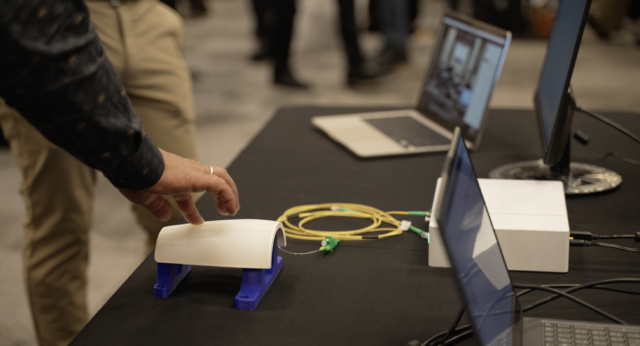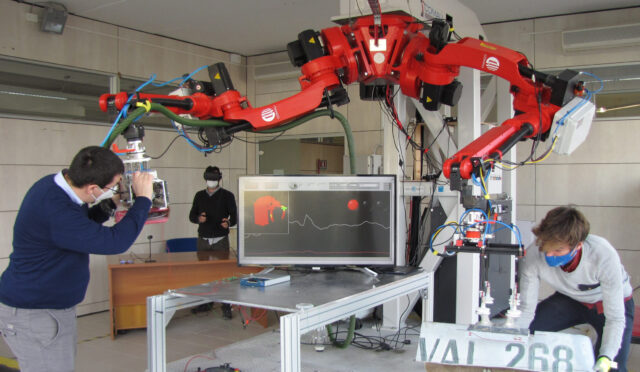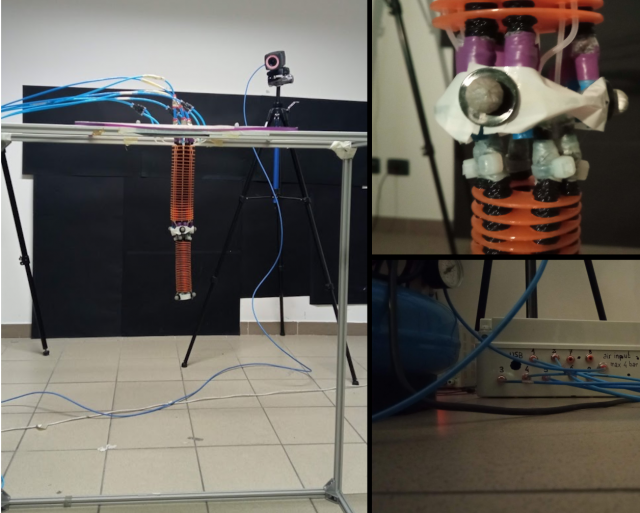HomeRobotic Database - Single Infrastructure | TERRINet


Address: Viale Rinaldo Piaggio, 34
56025 Pontedera PI, Italy
Website
https://www.santannapisa.it/en/institute/biorobotics/biorobotics-institute
Scientific Responsible
Paolo Dario
Vito Monaco
Andrea Mannini
About
The BioRobotics Institute of of Scuola Superiore Sant’Anna, founded in 2011, has built a vast wealth of knowledge and expertise in several fields of biorobotics, such as: assistive/rehabilitation/surgical robotics, neural engineering, cognitive systems, bio-inspired and soft robots, social robotics and industrial robotics. Biorobotics is a highly interdisciplinary, scientific-technological area, which merges robotics and biomedical engineering; in particular it is the science and the technology of the design and development of bioinspired robotics systems with biomedical application.
At present the Institute includes over 200 people: 23 faculty members, 90+ PhD students, 75+ research associates, 20+ technicians and administrative staff members, and a variable number of master students and visiting researchers. The headquarter of the BioRobotics Institute is hosted at the Polo Sant’Anna Valdera (PSV) established by the Sant’Anna School, in 2002, as a 6,300 square meters surface research park, in the industrial town of Pontedera (by train: 15 minutes away from Pisa and 45 minutes from Florence). The PSV is home of world class equipment for analysis, design and (micro-nano) fabrication and advanced robotics platforms developed by the research teams as well as classrooms and a guest house.
Presentation of platforms
Available platforms
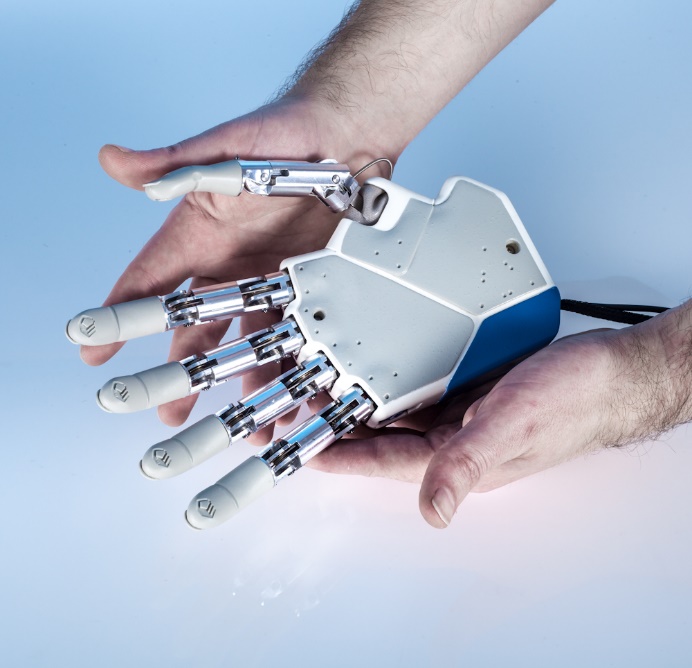
IH2 Azzurra Hand
Intrinsic robotic hand with all functional components (5 motors, tactile sensors and control electronics) integrated in the palm and in the underactuated, self-adaptive fingers. Able to perform multiple grasps and sense objects. Simple communication interface (RS-232 over USB or Bluetooth). Standard prosthetic wrist attachments available (compatible with Ottobock QWD). The compact size of these hands allows using them in research, evaluation and clinical experience with humans in real daily living environments on human-machine interfaces (either invasive or non-invasive) and control (EMG, ENG, EEG, sensory feedback systems, etc). Not only! Due to their light weight and anthropomorphism they are suitable as robotic end-effectors on limited pay-load robotic arms.

Da Vinci Research Kit (DVRK)
The da Vinci Research Kit (dVRK) is a research platform based on the da Vinci Surgical System developed and distributed by Intuitive Surgical Inc. The kit is a collection of first-generation da Vinci components that can be used to assemble a telerobotics platform which provides complete access to all levels of control via open source electronics and software. The platform consists of a surgeon’s console to tele-operate the surgery and a patient side system where the surgery takes place. The surgeon’s console consists of two Master Tool Manipulators, each having 8 DOF for dexterous and natural hand manipulation, and a foot-pedal tray. On the other side at the patient’s end, there are two Patient Side Manipulators, which are controlled by the two Master Tool Manipulators. The interface between the two components is based on custom hardware consisting of motor-controllers, coupled with FPGAs and connected to a PC running the control loops. The DVRK can be exploited for interfacing with different master manipulators, for testing force-feedback strategies, of for the integration on novel tools for surgery.

Neuromorphic Artificial Touch Sensors
Neuromorphic Artificial Touch Sensors are a platform composed by an artificial tactile finger equipped with an array of 4 tactile MEMS sensors (MicroTAF), each having 4 output channels, and single board RIO by National Instruments. It encodes not only the normal force but also tangential forces. Data generated from the fingertip can be raw, i.e., the conversion of MEMS outputs, or neuromorphic, i.e., with sequences of neural-like spikes. The artificial tactile finger is available in two versions, one with a thick covering layer emulating the firing behaviour of type II human mechanoreceptors (Ruffini and Pacini), and another with a thin covering layer emulating the firing behaviour of type I mechanoreceptors (Merkel and Meissner). The platform is capable to discriminate between surfaces with different roughness, even between different daily use surfaces (like glass, wood, paper and more). The artificial tactile finger can be mounted on the Azzurra Hand with a proper adapter or any other hand/arm with a simple mechanical interface.
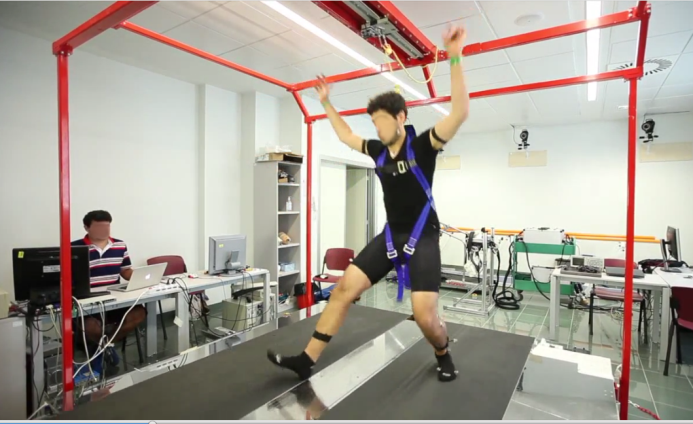
SENLY
SENLY is a mechatronic platform aimed at perturbing steady conditions, such us, walking or keeping the upright stance, by slipping-like perturbations. It mainly consists of a double split-belts treadmill which belts can be independently controlled along the fore-aft and medio-lateral directions, thus emulating multi-directional perturbations. SENLY is also provided with force cells allowing the users to evaluate the load distribution between the legs. Perturbations can be delivered either synchronously, that is, simultaneously with the Start command run by the user, or asynchronously, that is, when a particular load distribution on both platforms is detected.

InMotion wrist
The InMotion WRIST™ exoskeletal robot is capable of lifting even a severely impaired neurologic patient’s hand against gravity, overcoming most forms of hypertonicity. The InMotion WRIST™ exoskeletal robot accommodates the range of motion of a normal wrist in everyday tasks.

Robotic systems for high-fidelity neonatal simulation: training for medical doctors
Simulation-based training is increasingly emerging in Neonatal Intensive Care Units (NICUs), since high fidelity simulation has been confirmed as an effective instructional strategy to develop clinicians’ technical and non-technical skills needed for patient care.
By exploiting a strong collaboration with neonatologists, dedicated devices have been designed and realized both for training in neonatal intubation and mechanical ventilation.
The prototype has 5 compartments arranged to reproduce anatomical distribution. Each compartment is characterized by its own adjustable compliance, and right and left respiratory branches are subjected to an independent and adjustable resistance level. The simulator is designed so as to be compatible with mechanical ventilators commonly used in NICUs, showing active behavior.
With the final aim to provide medical doctors with mechatronic and robotic systems able to answer specific and different training needs, custom training kit can be designed and realized as described above, but by following the specific clinical requirements. In this case, an extra time should be devoted to the customization of the training devices.
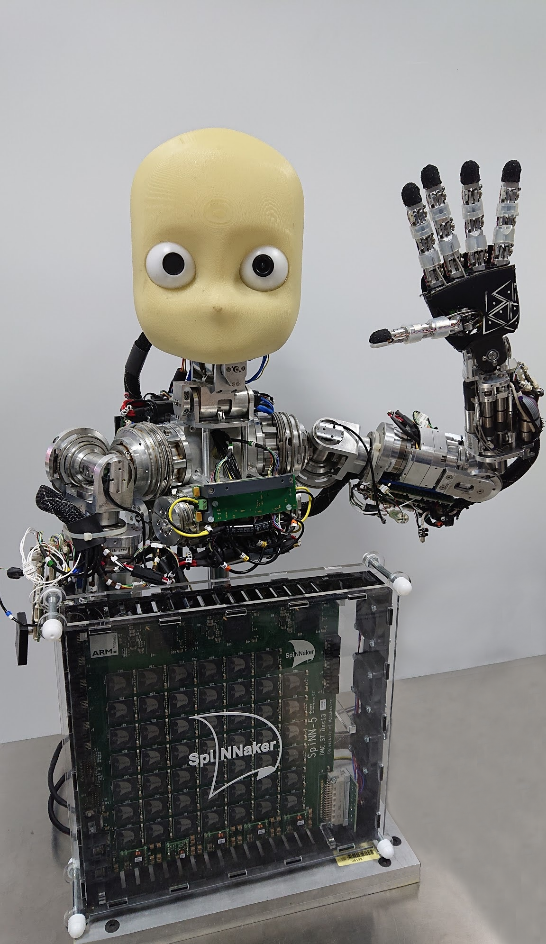
NeuiCub
The NeuiCub platform is composed of an iCub robot controlled through a SpiNNaker neuromorphic board (SpiNN-5). It is meant for neurorobotic experiments that involve detailed brain models implemented with spiking neural networks. The SpiNNaker neuromorphic platform comprises arrays of low-power, parallel custom chips (each containing 18 ARM9 cores) running a digital software simulation of neurons and synapses. The SpiNN-5 board includes 48 processors. The system’s philosophy focuses on large brain simulation and spike communication in real time whilst scaling up to biological scale. A standard SpiNNaker neural model is primarily configured through the provision of the “sPyNNaker” implementation of the Python-based PyNN modeling framework. The version of the iCub humanoid robot available at the BioRobotics Institute is provided with one head that has 6 degrees of freedom (dofs), 3 for eyes and 3 for neck control), two arms (7 dofs each) and one hand (3 dofs for the thumb, 2 for the index, 2 for the middle finger, 1 for the coupled ring and little finger, 1 for the adduction/abduction). The iCub robot available at the BioRobotics Insitute is equipped also with an inertial sensor, two dragonfly cameras and tactile sensors in the hand.

STIFF-FLOP soft manipulator
Modular soft manipulator with high dexterity and intrinsic safety. The manipulator is based on a modular approach and each module is 60 mm long and 14 mm in diameter. It is able to implement omnidirectional bending and elongation when pressurized (pressure range: 0 – 1.5 bar). The basic version of the manipulator is composed of two modules, completely based on elastomers (silicones) and some ABS parts for connection. On the tip, the system can lodge a micro camera, a gripper or an ablator (all tested)
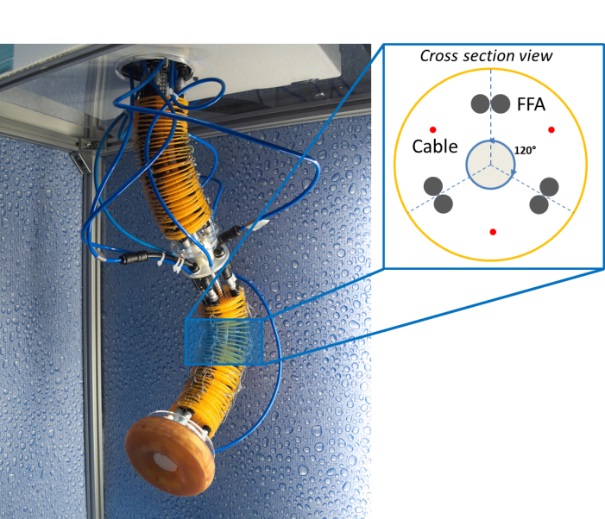
I-Support soft arm
The I-Support platform consists of a manipulator made of two identical interconnected modules. Each module, 60 mm in diameter and 200 mm in length, counts on: 3 couples of McKibben-based bellow-like flexible fluidic actuators (FFA) arranged at 60° with respect to 3 cables, an internal channel designed for the provision of water/soap but that can be exploited for passing some possible tools up to the tip and a layered structure along the module to drive the activation energy towards the right direction. Each module has elongation, contraction, omnidirectional bending, and variable stiffness capability. Furthermore, the manipulator being modular and implementing bowden-cable technology has multiple advantages, as follows: (i) fast replacement, (ii) the possibility of using one/two modules, (iii) local control of the single segment and (iv) an easy design for sensors integration. The manipulator has been designed for assisting elderly people during the showering task, but it can be used as a multipurpose platform for implementing and testing control algorithms for soft manipulators.
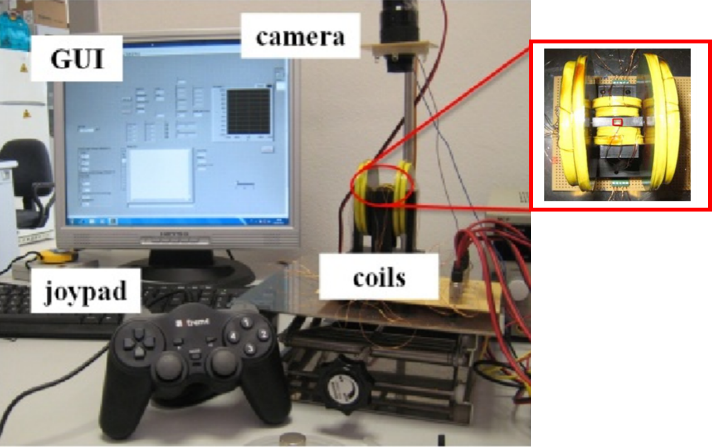
Magnetic Micro Manipulation Platform
The Magnetic Micro Manipulation Platform consists of a magnetic field generator and a control system. The magnetic field generator is composed by two orthogonal pairs of Helmholtz coils, which generate a uniform field, and two orthogonal pairs of Maxwell coils, which generate a uniform field gradient. The 2D workspace is 2 mm x 3.5 mm. The maximum magnetic field and gradient are 12 mT and 1.2 T/m, respectively, generated by currents in the range 0-2 A. The control system comprises a laptop, a joypad (SAITEK P580 Blue Rumble Pad), a camera (BASLER scA1390-17gc), a data acquisition board (NI DAQ USB-6259) and custom electronicsA custom electronics is avaiable and it is based on a closed loop op-amp configuration with a Darlington stage. The driving signals for the electronics are generated through the DAQ board by means of a software program developed in LabVIEW (National Instruments, Inc., USA). The magnetic fields and gradients are controlled by the user through the joypad interface. The GUI (graphical user interface) can be adapted in order to full-fill specific testing needs. At the same time, the camera for the 2D visualization of the workspace can be adapted depending on the type of microrobot which is under testing.

SILVER (Seabed-Interaction Legged Vehicle for Exploration and Research)
SILVER is a four-legged underwater vehicle. Each leg is based on a crank-slider mechanism with a serial spring, and two rotational joints at the hip (3 DoF each leg). Twelve Dynamixel AX-12a smart servomotors are connected in daisy chain, and powered by a LiPo battery for an average autonomy of 2 hours. The structure in PVC can hold sensors such as cameras, laser scan, salinity, pressure and temperature sensors, etc., or it can mount robotic arms or grippers. Matlab controllers, running on an external (out of water) laptop, enable SILVER with hopping, walking and crawling gaits. The self-stabilizing gaits, the reduced disturbances induced on sand during locomotion, and the peculiar underwater capability grants to the robot unique features for the investigation of seabed or for the study of legged locomotion in reduced gravity environment.
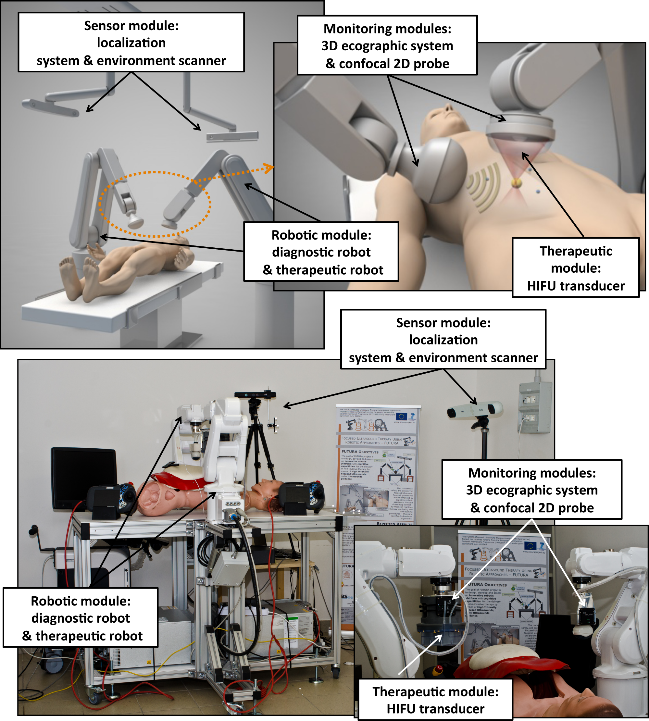
FUTURA platform for US-guided HIFU treatment
The FUTURA system is a robotic-assisted platform designed for Ultrasound-guided High Intensity Focused Ultrasound (HIFU) treatment. The control of two independent anthropomorphic manipulators provides the FUTURA platform with high flexibility in terms of operating workspace and maneuverability. The platform is composed of: i) a robotic module, ii) a therapeutic module, and iii) a monitoring module. The robotic module is composed by two anthropomorphic industrial manipulators (i.e., ABB IRB 120) equipped with two force/torque sensors (ATI mini 45). The monitoring module is composed by two different US probes: i) a 2D imaging US probe (Analogic Ultrasound PA7-4/12) confocal to the HIFU transducer, and ii) a motorized 3D imaging US probe (Analogic Ultrasound 4DC7-3/40) mounted on the second manipulator, both connected to the Analogic Ultrasound SonixTablet machine. The therapeutic module consists of a custom-made Focused Ultrasound System. This system has three main components: i) a multi-channel high power signal generator (Image Guided Therapy), ii) a 16 channels phased annular array transducer (Imasonic), and iii) a coupling system (small pillow filled with water) which provides a good acoustic path between the transducer and the patient. The remote control on the FUS generator allows to adjusts the shooting parameters (e.g. focal depth) with a frequency of 20 Hz. The different modules of the FUTURA platform are mutually controlled through dedicated software developed in Robot Operating System (ROS) framework. The FUS treatment is managed by the users through a dedicated Human Machine Interface with real-time visualization of the working scenario. The high modularity of the platform allows for the testing of different modalities: specific experiments dedicated to image guidance, force controlled contact with human tissues, obstacle avoidance strategies between manipulators and patients/operators can be also set-up in the framework of the overall structure.
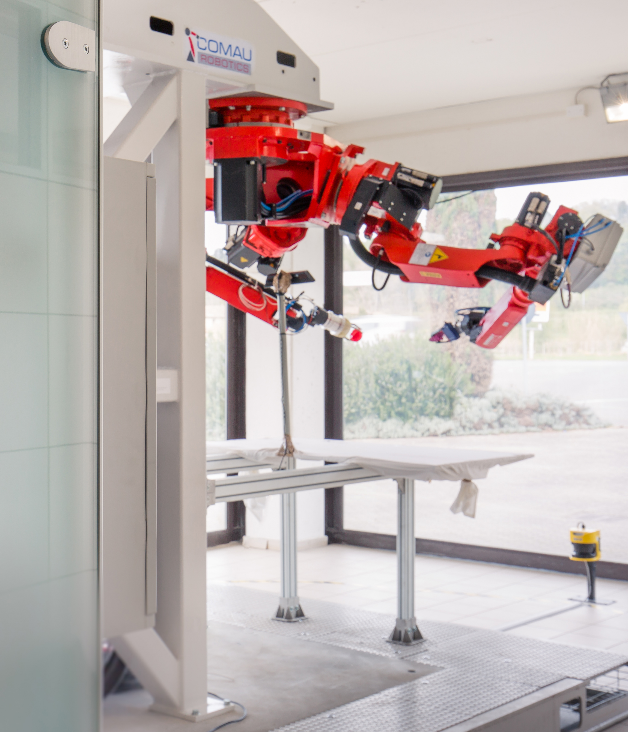
COMAU Dual arm robot
The Comau Smart Dual arm robot is a robotic system especially designed to perform assembling tasks. It is based on an innovative humanlike approach, having a sensor based platform and cognitive functions in order to support the assembling process. Its ease of use and the cooperation with humans in the different phases of each task, makes it ideal also for SME applications. Currently a lot of new devices and solution are under development: • Devices for fenceless approach (safety eyes by PILZ, stereocameras) • Vision system for parts recognition • Force torque sensor • Devices for easy programming (gesture and vocals recognition) • A Kinect v2 • Festo and Schunk grippers • Integration of C5G open control and ORL libraries. C5G Open is suitable for industrial application that need additional sensors integrated in the system. For this purpose, used hardware parts have to be compliant with the industrials regulations.




